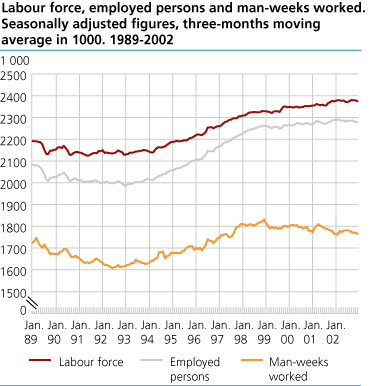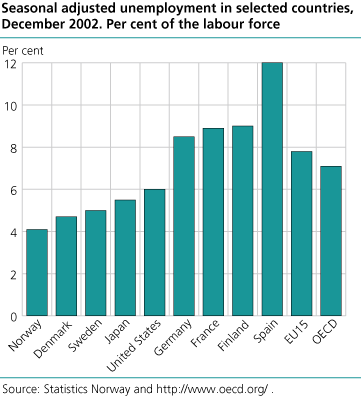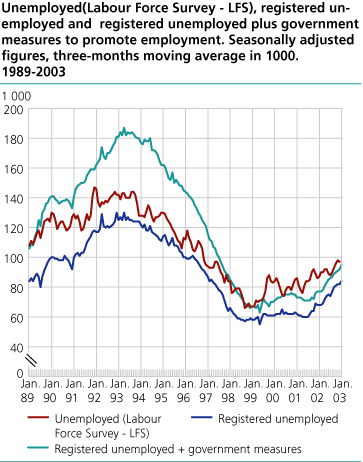Content
Published:
This is an archived release.
Employment down
Numbers of employed persons decreased and numbers of unemployed persons increased slightly the last 3 months period. The numbers are adjusted for seasonal variations.
The employment has shown only a slight increase from 1999 and onwards, after a period of strong growths. Through 2002 the numbers of employed persons have been just about unchanged. From the 3-months period August - October 2002 to November - January, the numbers of employed persons decreased by 9 000, which is about at the error margins.
Norwegian unemployment has shown a weak increase since the autumn 1999 according to seasonally adjusted figures from the LFS. From the 3-months period August - October 2002 to November - January total unemployment increased by 3 000 persons. In per cent of the labour force the number of unemployed persons increased by the lower edge of 0.2 percentage points, which is inside the error margins. Seasonally adjusted figures of registered unemployed persons at the Employment Offices the last year also indicate an increasing unemployment.
Man-weeks worked decreased
Man-weeks worked have shown a decreasing trend since autumn of 1999. It looks like the latest figures support the trend, however the decrease in man-weeks worked of 9 000 the last 3 months period is within the error margins.
Unemployment increased in the EU and the OECD
The seasonally adjusted unemployment rate in Norway increased from 3.9 per cent in September 2002 to 4.1 per cent in December. In the same period the unemployment increased from 7.7 to 7.8 per cent as an average in the EU member countries. The unemployment rate in the OECD-countries as a whole increased from 6.9 to 7.1 per cent. In December 2002 the unemployment rate amounted to 6.0 in USA, 0.4 percentage point higher than in September. The unemployment rate in Sweden was unchanged at 5.0 per cent, while it was unchanged at 4.7 per cent in Denmark. In Finland the unemployment rate decreased from 9.1 to 9.0 per cent. This is according to figures from OECD .
Uncertain man-weeks estimates
Previous to the seasonal adjustment, we also make adjustments for holidays that fall in random months every year. Due to the fact that New Year's Day fell on a weekday in January this year and many people have Christmas vacation until that Wednesday or throughout the week, we adjust the figure of man-weeks worked up by 100 000 prior to the seasonal adjustment. Partly the adjustments are made so that the relative change in average weekly working hours from November to January this year is like last year's. In addition the holiday absence rates are set equal to the corresponding absence rates in the reference year 1991 in order to get comparable time series. Due to this the latest man-weeks estimate is more uncertain than normal.
Uncertainty
The purpose of adjusting for seasonal variations is to describe the development during the last year and to give figures for change between the last two 3-month periods, cleared for normal seasonal variations. Quality tests show that the seasonally adjusted LFS unemployment figures are uncertain. The seasonal-adjustment method has problems identifying a stable seasonal pattern for this series. The random component is relatively large compared to the seasonal component. In addition there are only a few unemployed persons, which may result in the uncertainty being considerable. The figures should therefore be used with caution. In order to reduce uncertainty, the presented series are three months moving averages of the seasonally adjusted figures. For instance the figure from December is the average of the estimates from November, December and January.
Tables:
The statistics is published with Labour force survey.
Contact
-
Arbeidsmarked og lønn
E-mail: arbeidsmarked@ssb.no
-
Erik Herstad Horgen
E-mail: erik.horgen@ssb.no
tel.: (+47) 93 08 68 62
-
Ole Sandvik
E-mail: ole.sandvik@ssb.no
tel.: (+47) 99 04 82 06



